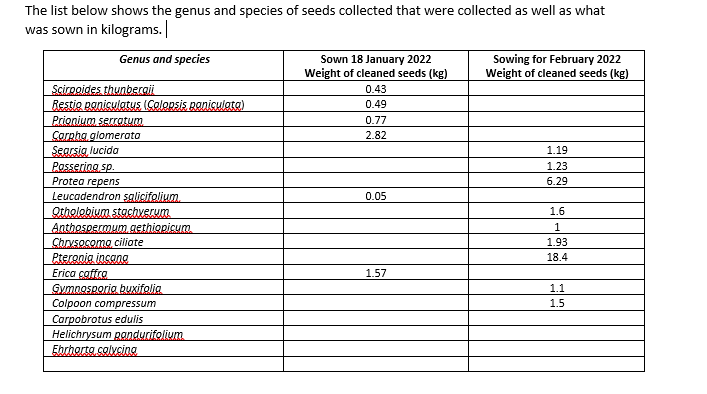|
We are reflecting on a rehabilitation project that we assisted with in Barrydale during December 2021 and January 2022. It was a unique experience and our team learned so much. The Project The Barrydale Rehabilitation project was complete through the directorate: Pollution and Chemicals Management, Department of Environmental Affairs and Development Planning, Western Cape Government. BioAssets CC was the contracted supplier and Wynand asked Johann van Biljon (Intaba environmental services) for assistance as the subcontractor. Johann invited Grootvadersbosch Conservancy for assistance as it would be difficult to bring his staff from Tulbagh and we were very excited to be involved in another rehabilitation project. How did it start? We first met Johann van Biljon on a field trip to Tulbagh as part of the Annual Fynbos Forum. Johann works as the manager of Intaba environmental services, which provides environmental consultation, eco landscaping, and ecosystem rehabilitation services. We attended a workshop at their Tulbagh operation, unaware that we would be working together very soon. In the workshop, we interacted with Johann’s staff, were invited into his home, and got a chance to see some of the rehabilitation projects that he has completed. It was fascinating and inspiring to see what they have accomplished. Soon after this workshop, BioAsssets won a tender to work in the Barrydale area. Dr Wynand Vlok, owner of Bio Assets, specialises in freshwater ecological research, environmental impact assessments as well as wetland research. He needed some additional input and called on Johann for help. Johann needed a local partner, and we were happy to assist. Johann is a wealth of knowledge, and it was a pleasure to collaborate with him. He would share his knowledge with the team and tell all sorts of interesting and, sometimes, funny stories. He is also very hands on and cares about people and their aspirations. For example, when he asked some of us to accompany him on a walk to collect some Gymnosporia buxifolia seeds, he asked us about our goals and what we wanted to become one day. One of the team members wanted to be a mechanic and Johann inspired him to explore his dreams. Aims of the project One of the main goals was to replant indigenous plants along the riverbanks that had been cleared of invasive vegetation. The advantages that would come from this project, included increased biodiversity in the landscape, which can help to mitigate the effects of extreme weather conditions, such as flooding. One of the project's objectives was to improve the Huis River's ecological functioning. Seed collection For the project, the conservancy used one of our teams that usually works on alien clearing. The contractor, Yolande Cupido, is based in Suurbraak, and she accepted the work for her team. A team of 12 workers was assembled for the Barrydale seed collection. The plan was that the seed collection would take place over a few days and the seeds would then go back to Tulbagh with Johann to clean and prepare. They would then be brought back for planting in Barrydale. We collected a mixture of seeds which included Helichrysum patulum and Athanasia trifurcatas, Protea repens, Searsia lucida and Erica caffra seeds. Preparing the seed Some of the seeds were taken by Johann to Tulbagh to prepare the seeds. Preparation can include sorting, cleaning, and washing. In some cases they are then also germinated. Sowing Seeds The seeds that did not go with Johann to get prepared, got sown immediately on the side of the river. Carpobrotus edulis is an amazing riverbank stabilizer and was sown along the riverbanks. Some of the workers mentioned that you can cut a piece off and then plant it, which was interesting to hear. Johann kept on telling stories and keeping the spirits high. He inquired if we knew the Khoisan name of Carpobrotus edulis? It is called ghoenavy, or ghaukum, which some of us used to eat as children (so tasty!). We continued to sow the seeds that had been prepared in Tulbagh and the seeds that we had just collected. We went on and planted palmiet (Prionium serratum) which Johann had germinated in Tulbagh. Wynand demonstrated how to plant the palmiet in the river's wet zone. We planted it where the river's speed is reduced, so that when the river is in motion, the palmiet plant will thrive and be shaded and protected. Some of the seeds were not ready to plant yet so we were forced to leave them out of the planting, such as Metalasia densa seeds. However, we plan to work on the project for 2 more days at a later stage. The team learned a lot from the two natural gurus about the indigenous plants, how to plant them, and where to plant them. We also discovered which plants grow in the area and which do not. Overall, the project was interesting and enjoyable. This project was fun for the teams to work on and we all learnt a lot.
Thank you to Intaba Environmental and BioAssets for involving us.
0 Comments
Your comment will be posted after it is approved.
Leave a Reply. |
AuthorGVB Conservancy Staff Archives
May 2024
Categories |

 RSS Feed
RSS Feed






